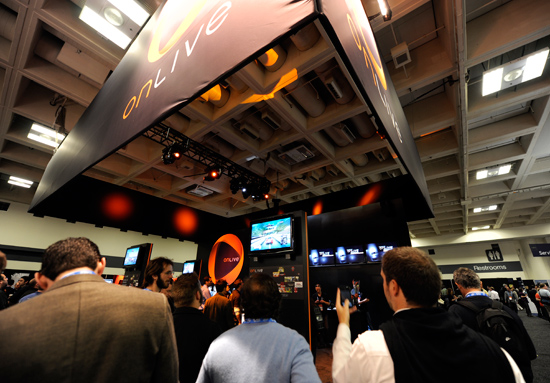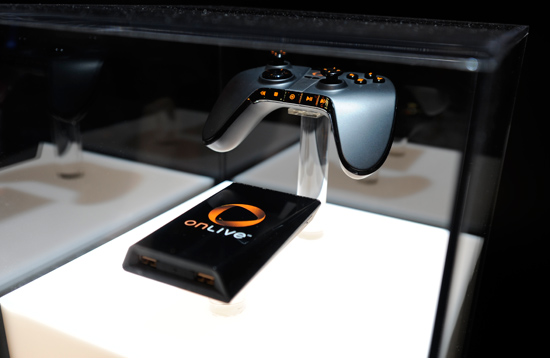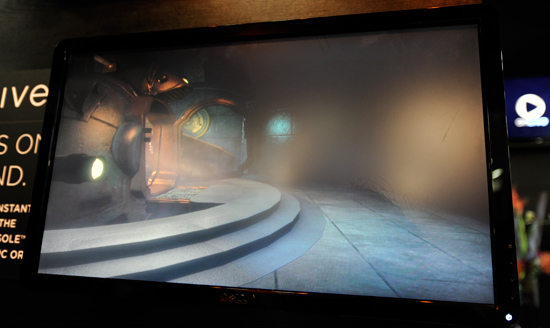Nintendo's Development Secrets, Cloud Gaming & new Killer NIC - GDC '09
by Anand Lal Shimpi & Derek Wilson on March 26, 2009 12:00 AM EST- Posted in
- Trade Shows
OnLive: Gaming Without the Hardware Requirements
I first read about OnLive before I ever set foot on the GDC show floor thanks to Dean Takahashi’s story on the service. If you haven’t read about it, here’s what it does.

Today when you go to play a 3D game like BioShock or Unreal Tournament III, the rendering is done on your PC or console. There’s a reasonably powerful GPU and a fast CPU in your machine and it goes about calculating the color of every pixel on your screen and the impact of every explosion. The more demanding the game, the more powerful your CPU and GPU have to be.
Instead of doing that rendering locally in your home on your PC or console, OnLive seeks to do it remotely on powerful high end servers and simply stream the rendered frames to you, compressed, over the Internet.
OnLive claims that its compression technology is good enough to deliver HD resolution gaming over a standard Internet connection, without the need for a high speed PC or console. The bandwidth requirements are about 1Mbps for a 640 x 480 resolution and 5Mbps for 1280 x 720. The data compression algorithms are adaptive, so if you have poor network conditions the quality of the video sent to your screen will go down to compensate.
The benefit of OnLive is that you can play any title on any platform. OnLive will be supported on PCs, Macs and directly connected to a TV using a very light hardware client. There’s no word on pricing yet.

OnLive running on a MacBook

...and on a Dell notebook

...or on the OnLive "console" hardware; basically a video encoder, ethernet and a USB port.
OnLive does have major game developer support. The list of developers includes the big names: EA, Ubisoft and Epic.
I played BioShock at OnLive’s booth. The game was streamed to me over the Internet and for the most part, it looked and felt like BioShock. The game didn’t look as good as running on a PC with a high end graphics card, and it felt like there was some sort of frame rate smoothing going on, but the technology worked.

BioShock over the Internet. Cool.
The implications are huge. You wouldn’t need a high end PC or console to play the latest games. Game prices could be cheaper thanks to cutting out publisher and retail store overhead. Cross-platform multiplayer gaming would now be possible; if BioShock were a multiplayer game, you wouldn’t have to worry about which version was being played - you could play on your Mac with your friend on his/her PC.
OnLive is supposed to launch by the end of 2009.










38 Comments
View All Comments
arturnowp - Friday, March 27, 2009 - link
Resolution is not that big problem. Imagine 720p with 16x AA. There is resolution bound caused by netword bandwidth not because of data center perfomance.MrSAballmer - Thursday, March 26, 2009 - link
Interesting stuff here, especially the fishnet-girls!http://fakesteveballmer.blogspot.com">http://fakesteveballmer.blogspot.com
spuddyt - Thursday, March 26, 2009 - link
I mean, a fat red plumber jumping on mushrooms....drwheel - Thursday, March 26, 2009 - link
That's how the article reads anyway.It amazes me that bigfoot networks is still in business. Another killer nic product that delivers marginal improvements that are rivalled by a $25 intel card:
http://forum.ncix.com/forums/topic.php?id=1304406">http://forum.ncix.com/forums/topic.php?id=1304406
And a streaming video game system! Awesome. Seeing as how gamers like myself already complain about latency on lcd monitors that claim to have single-digit ms response times (not always true), or who can easily notice a different between at 20ms versus a 100ms ping time to a game server, I'm sure throwing another 80ms of lag in there because your game is being pre-rendered elsewhere won't hurt either! Haha.
What a joke. Is this the best stuff there is to report about at GDC?
SSDMaster - Thursday, March 26, 2009 - link
They've really done something unique with onLive though... you gotta hand it to them.They've created a new type of lag.
Before you just had to wait till the server showed you where your enemies were, but NOW you get to wait to see your character turn every time you hit the control stick...
GENIUS!
drwheel - Thursday, March 26, 2009 - link
And let's not forget the other issues with this platform aside from latency. This company better have a ginormous data center with tons of mid to high-end systems, each one with a dedicated gfx card for each player, and gobs and gobs of bandwidth on a very reliable backbone. We're talking about AIG bailout money here.This entire venture just sounds like something that will never get off the ground. And even if it does, there is a list of logistical issues that will cause it to fail. Sorry, but this sounds like the next "Sega Channel" or better yet... Phantom game console.
Good idea, but there is no way it will ever work. Atleast, not until this country's network infrastructure is improved to a point where coast-to-coast latency is in the single-digit millisecond range, and everyone has atleast 10Mbps bandwidth in their home (read: not for at least another 10 years).
bespoke - Thursday, March 26, 2009 - link
"And let's not forget the other issues with this platform aside from latency. This company better have a ginormous data center with tons of mid to high-end systems, each one with a dedicated gfx card for each player, and gobs and gobs of bandwidth on a very reliable backbone. We're talking about AIG bailout money here."Right - this is the point I don't understand. We've got to be talking about quite huge hardware investment per user to run these things. Maybe $500 of hardware per user? Are these guys really going to spend that much money up front? Are they going to be able to recoop that money? Will they upgrade hardware every 6-12 months to stay up with games?
baba264 - Thursday, March 26, 2009 - link
I believe I may be able to offer some insight on this question. In my opinion you forget three major facts.The first one is that the game resolution offered are calibrated for the tv. Either standard 800x600 tv, or 1024*720 HD tv, but either way, compared to the kind of resolution we're talking about in a high end gaming rigg, this is very low.
The second fact is that they're probably not going to be running their games on indivdual pc, but rather on a cluster of workstations with high end graphic cards and maybe dedicated hardware for physics rendering. Considering the resolutions involved, one may be able to run quite a few instances of a game on a single machine.
The third is that, given the resolutions offered and the latency issues, this seems to me like a product aimed much more at the console crowd and maybe the notebook crowd than at the pc gaming one.
To sum it up there must be some large input of money to start up the thing, but if it's well designed, one may be able to add to load capacity without changing the architecture, just by plugging in new machines. So the initial investment is just a few machines and all the design and software to run the thing. Furthermore, one does get some economy through scaling so the number are not as bad as they seem. And since it's aimed mostly at the console crowd, that's more used to latency, the add up might not be an issue in most games.
So all in all, seen as something to replace your console (and not your pc) or to get into gaming if you don't have any hardware yet, this seems like a fairly good idea to me. However, I am concerned, as others have expressed before me, with the impact this traffic will have on Internet as a whole if this service becomes popular.
araczynski - Thursday, March 26, 2009 - link
i'm really hoping onlive gets traction, it would catch the industry off guard at the least, but i'd think for the most part the developers would love it.great way to fight piracy and gamestop, not to mention opening up a whole new potential userbase for developers to sell to, i.e. those that don't want to waste time/money on buying/building crazy gaming rigs.
the 720p limitation at the moment does worry me a bit, but then again that's probably not that big of an issue when the device is hooked up to say a laptop screen, as opposed to a tv/monitor.
in any case, broadband speeds are only increasing, even in the backwater US, so full 1080p shouldn't be all that far off.
The0ne - Thursday, March 26, 2009 - link
Speed increase with download/upload caps. Yea, good combo alright.